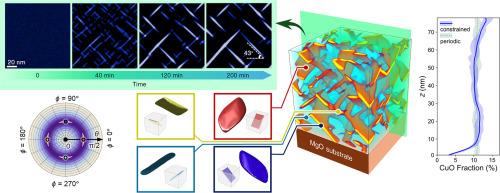Phase-field study of precipitate morphology in epitaxial high-entropy oxide films
IF 8.3
1区 材料科学
Q1 MATERIALS SCIENCE, MULTIDISCIPLINARY
引用次数: 0
Abstract
High-entropy oxides (HEOs) with multiple equal-molar cations may exist as single-phase solid solutions at sufficiently high temperatures. However, such solid solutions are susceptible to the formation of stable or metastable precipitates at lower temperatures. The morphology of such precipitates could have profound influence on the resulting properties. Here, we extended our recently developed phase-field model of simultaneous solid solution and stoichiometric phases for binary alloy systems to multicomponent oxides. Using the stress-free lattice parameters and elastic constants of precipitate phases as well as the interfacial energy between the precipitate and the solid solution matrix from density-functional theory calculations, we performed phase-field simulations to understand the morphology of coherent CuO-rich precipitates in epitaxial Mg0.2Co0.2Ni0.2Cu0.2Zn0.2O thin films validated by transmission electron microscopy (TEM) observations. By analyzing the detailed precipitate sizes, orientation, and spatial distributions as well as the stress and strain distributions along different cross-sections, we reveal the important impact of elastic constraints on the CuO precipitate distributions in thin films. These findings can provide useful insights into controlling the coherent precipitate morphology in epitaxial HEO thin films.


外延高熵氧化膜中沉淀形态的相场研究
具有多个等摩尔阳离子的高熵氧化物(HEOs)在足够高的温度下可以作为单相固溶体存在。然而,这种固溶体在较低温度下容易形成稳定或亚稳定的沉淀。这种沉淀物的形态对最终的性能有深远的影响。在这里,我们扩展了我们最近开发的二元合金系统的同时固溶体和化学计量相的相场模型到多组分氧化物。利用密度函数理论计算得到的无应力晶格参数、析出相弹性常数以及析出相与固溶体基体之间的界面能,进行相场模拟,以了解经透射电镜(TEM)验证的mg0.2 co0.2 ni0.2 cu0.2 zn0.2 2o外延薄膜中相干富cuo析出相的形貌。通过对CuO析出相尺寸、取向、空间分布以及不同截面应力应变分布的详细分析,揭示了弹性约束对薄膜中CuO析出相分布的重要影响。这些发现可以为控制外延HEO薄膜的相干析出形态提供有用的见解。
本文章由计算机程序翻译,如有差异,请以英文原文为准。
求助全文
约1分钟内获得全文
求助全文
来源期刊

Acta Materialia
工程技术-材料科学:综合
CiteScore
16.10
自引率
8.50%
发文量
801
审稿时长
53 days
期刊介绍:
Acta Materialia serves as a platform for publishing full-length, original papers and commissioned overviews that contribute to a profound understanding of the correlation between the processing, structure, and properties of inorganic materials. The journal seeks papers with high impact potential or those that significantly propel the field forward. The scope includes the atomic and molecular arrangements, chemical and electronic structures, and microstructure of materials, focusing on their mechanical or functional behavior across all length scales, including nanostructures.
 求助内容:
求助内容: 应助结果提醒方式:
应助结果提醒方式:


